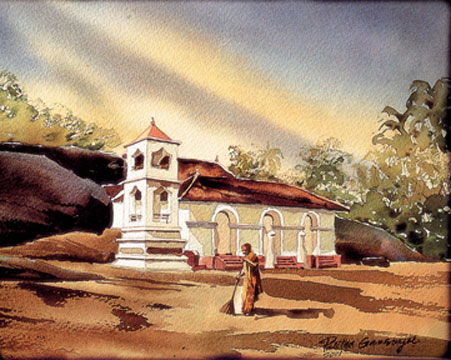Painter inspired by nature
 When the question of how to organise my material arose I decided that
artists should be introduced strictly in the order of their appearance
in the world. To insist upon an artist's identity with a group is to
compromise his individuality. Groups have a way of dissolving under
scrutiny, of proving to be more fortuitous in their composition and more
ephemeral than they at first appeared. When the question of how to organise my material arose I decided that
artists should be introduced strictly in the order of their appearance
in the world. To insist upon an artist's identity with a group is to
compromise his individuality. Groups have a way of dissolving under
scrutiny, of proving to be more fortuitous in their composition and more
ephemeral than they at first appeared.
Unlike the individuals who compose them, they have no hard core.
Earlier,less disintegrated periods, there was some meaning in the
classification of artists according to the tradition to which they
belonged but at the present time the general enfeeblement and even
collapse of tradition has made the classification of original artists
almost impossible. They exist by virtue of their individual selves
alone.
I have tried to evoke a degree of recognition of value of their art
and interest in their lives and personalities.
Those artists who are included in this series of 'Contemporary
artists' for the first time were added because they seemed to me that
they are not given their due place and recognition. I have in fact paid
a tribute to a number of other senior artists in a series under 'Old
masters'.
 |
|
Palitha Gunasinghe |
The volume of talent in Sri Lanka in the present century has been
inspiring. Such an artists is an exponent of the water colour medium.
The multi-talented artist is Palitha Gunasinghe who hails from Kalutara.
Palitha was born in a village called Meegahathanna in the Kalutara
district.
He grew up in a picturesque site where lush green paddy fields nestle
in the valley, rows of huge rubber trees and coconut palms of fat shady
growth that spreads from shoulder to shoulder.
To the north the view is so lovely against which the surf dashed and
formy jets ran high up against the rocky shore, a long, curved sandy
beach bordered with thatched or cadjan huts, and the sky above them is
dappled with fast moving clouds.
The surroundings, and the villagers with their simple life-style
enriched Palitha's artistic creativity.
He had his primary education at Ratmale village school and completed
his secondary education at Meegahathanna Maha Vidyalaya and Ovitigala
Maha Vidyalaya in Mathugama.
From the age of three years he had selected a few charcoal pieces and
drew animals, human figures and birds on the walls and the floor in the
meda midula (court yard) of his native home. His father soon realised
that Palitha would be no scholar so he encouraged him to do more
drawings.
He sent some of his son's work to a children's newspaper Mihira which
was quick to publish them. Even in school his artistic and literary
skills were recognised and had won many awards at school exhibitions. He
came under the influence of reputed art teachers who taught him the
rudiments of traditional art and other indigenous art forms. Very soon
he had won the admiration of his parents and villagers for his excellent
drawings.
 |
|
The temple at
Degaldoruwa |
 |
|
A bullock cart passing
a cottage |
Soon after he completed his education he joined the Sarvodaya
Movement and created a stamp for their 25th anniversary. This won him a
scholarship to be trained in graphic art and designing in the
Nertherlands. The trip also paved the way for Palitha much needed
exposure to the international art world where he had the opportunity to
visit art galleries museums and studying the work of old masters.
Palitha Gunasinghe represented the life of mankind. The scope of his
genius included landscape paintings, mythological scenes, realistic
stories, symbolical representations, tragedy, comedy, satire, men, gods
and devils. The most evocative of all were the fishermen and women at
the nets, the boat men returning home and some mending their nets. His
paintings also included historic Buddhist temples, Hindu Kovils and
churches. Palitha is a pictorial rather than a photographic painter. He
is a realist with an imagination. And his art is so alive, so spirited,
so impetuous, that it kindles a sympathetic spark of imagination in the
most sluggish of his spectators. He is a excellent painter in new
landscapes, new visions, new secrets of nature to capture and to
interpret upon the canvas.
His landscapes are prayers in colour, poems of adoration to the
gentle beauties of nature. He always painted direct from life. "Do not
follow others", he said. "He who follows is always behind... You must
interpret nature with entire simplicity and according to your personal
sentiment. Listen to the criticism of others," he said and "let your own
feelings be your guide."
He had designed many stamps marking several milestones in the
nation's progress and the Government Philatelic Bureau has accepted him
as a excellent stamp designer. He began life as a commercial artist in
the advertising field and rose up as a art director and later quit
advertising so that he would be able to commit himself totally to
creative art.
He describes water-colours as a 'highly expressive form of art that
is both exciting and enjoyable.
He further says that a water-colour artist is capable of capturing
the glories of nature with its many strokes of light and dark and in
between misty shades with a few strokes of his brush. At present he
works from home attracting tourists and intends to open his own art
gallery named 'Siththara Arana' (Art house).
|

